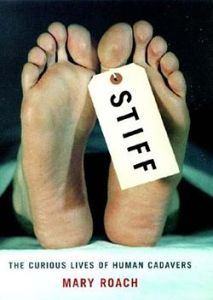
Author: Mary Roach
Publisher: W.W. Norton & Company, 2003 (Hardcover, 292 pages)
Rating: ![]()
Memorable Quotes:
“The gains in the average person’s understanding of biology have, I imagine, worked to dissolve the romance of death and burial–the lingering notion of the cadaver as some beatific being in an otherworldly realm of satin and chorale music, the well-groomed almost-human who simply likes to sleep a lot, underground, in his clothing.” p. 57
“Life is looking rosy for our one-celled friends. They’ve already been enjoying the benefits of a decommissioned human immune system, and now suddenly, they’re awash with this edible goo, issuing from ruptured cells of the intestine lining. It’s raining food. As will happen in times of plenty, the population swells. Some of the bacteria migrate to the far frontiers of the body, traveling by sea, afloat in the same liquid that keeps them nourished.” p. 66
“Life contains these things: leakage and wick age and discharge, pus and snot and slime and greet. We are biology. We are reminded of this at the beginning and the end, at birth and at death. In between we do what we can to forget.” p. 84
“It is an unfortunate given of human trauma research the the things most likely to accidentally maim or kill people–things we most need to study and understand–are also the things most likely to mutilate research cadavers: car crashes, gunshots, explosions, sporting accidents. There is no need to use cadavers to study stapler injuries or human tolerance to ill-fitting footwear.” p. 152
“A patient on the way to surgery travels at twice the speed of patient on the way to the morgue. Gurneys that ferry the living through hospital corridors move forward in an aura of purpose and push, flanked by caregivers with long strides and set faces, steadying IVs, pumping Bambu bags, barreling into double doors. A gurney with a cadaver commands no urgency. It is wheeled by a single person, calmly and with little notice, like a shopping cart.” p.167

